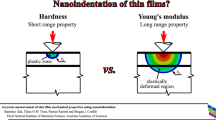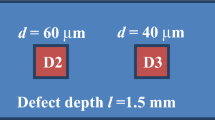Abstract
Modern methods for determining the hardness, Young’s modulus, elastic recovery, adhesive/cohesive strength, friction coefficient, and wear resistance of thin films, coatings, multilayer materials, and bulk materials are considered. The experimental data obtained in instrumented indentation, instrumented scratching, and tribological tests of nanostructured and quasicrystalline coatings and composite materials are analyzed. It is noted that the elastic recovery of a number of advanced materials is higher than the elastic recovery of metal alloys by a factor of 2–3. The coefficients of sliding friction of sintered samples and thin films containing Al-Cu-Fe quasicrystals are found to be relatively low. An increase in the fraction of quasicrystalline particles to 30% in composites with an aluminum matrix leads to an increase in the wear resistance.
Similar content being viewed by others
References
A. A. Voevodin, D. V. Shtansky, E. A. Levashov, and J. J. Moore, NATO Sci. Ser., II 155, 319 (2004).
H. R. Hertz, Z. Reine Angew. Math., No. 92, 156 (1882).
L. Landau and E. Lifshitz, Course of Theoretical Physics, Vol. 7: Theory of Elasticity (Nauka, Moscow, 1986; Butterworth-Heinemann, Oxford, 1986).
J. Musil, H. Zeman, F. Kunc, and J. Vlček, Mater. Sci. Eng., A 340, 281 (2002).
S. Veprek, S. Mukherjee, H.-D. Mannling, and J. L. He, Mater. Sci. Eng., A 340, 292 (2002).
V. S. Zolotarevskiĭ, Mechanical Properties of Metals (MISiS, Moscow, 1998) [in Russian].
G. M. Gamilton, Proc. Inst. Mech. Eng., Part C 197, 53 (1983).
W. C. Oliver and G. M. Pharr, J. Mater. Res. 7, 1564 (1992).
S. I. Bulychev and V. P. Alekhin, Testing Materials under Continuous Indentation (Mashinostroenie, Moscow, 1990) [in Russian].
G. M. Pharr, Mater. Sci. Eng., A 253, 151 (1998).
M. I. Petrzhik, M. R. Filonov, K. A. Pecherkin, et al., Izv. Vyssh. Uchebn. Zaved., Tsvetn. Metall., No. 6, 62 (2005).
M. I. Petrzhik, D. V. Shtanskiĭ, and E. A. Levashov, in Proceedings of the X International Scientific and Engineering Conference “High Technologies in the Industry of Russia,” Proceedings of the XVI International Symposium “Thin Films in Electronics”, Moscow, Russia, 2004 (OAO TsNITI “Tekhmash,” Moscow, 2004), p. 311 [in Russian].
D. V. Shtansky, A. N. Sheveiko, M. I. Petrzhik, et al., Surf. Coat. Technol. 200, 208 (2005).
Author information
Authors and Affiliations
Corresponding author
Additional information
Original Russian Text © M.I. Petrzhik, E.A. Levashov, 2007, published in Kristallografiya, 2007, Vol. 52, No. 6, pp. 1002–1010.
Rights and permissions
About this article
Cite this article
Petrzhik, M.I., Levashov, E.A. Modern methods for investigating functional surfaces of advanced materials by mechanical contact testing. Crystallogr. Rep. 52, 966–974 (2007). https://doi.org/10.1134/S1063774507060065
Received:
Issue Date:
DOI: https://doi.org/10.1134/S1063774507060065




